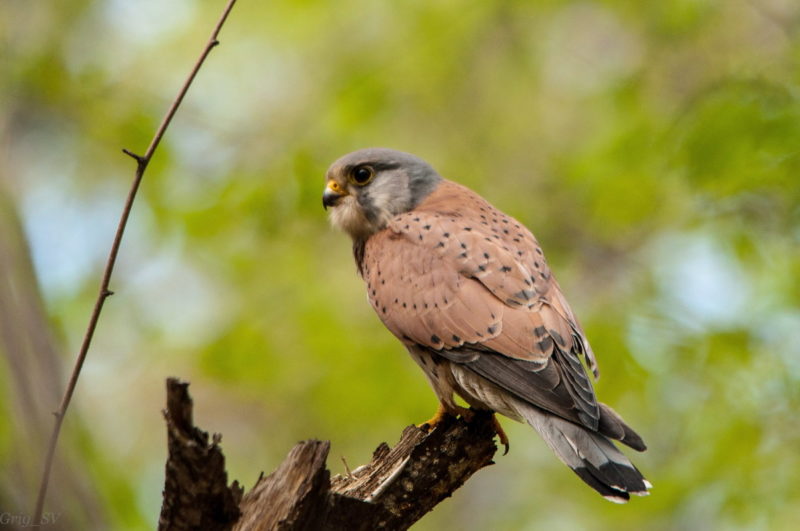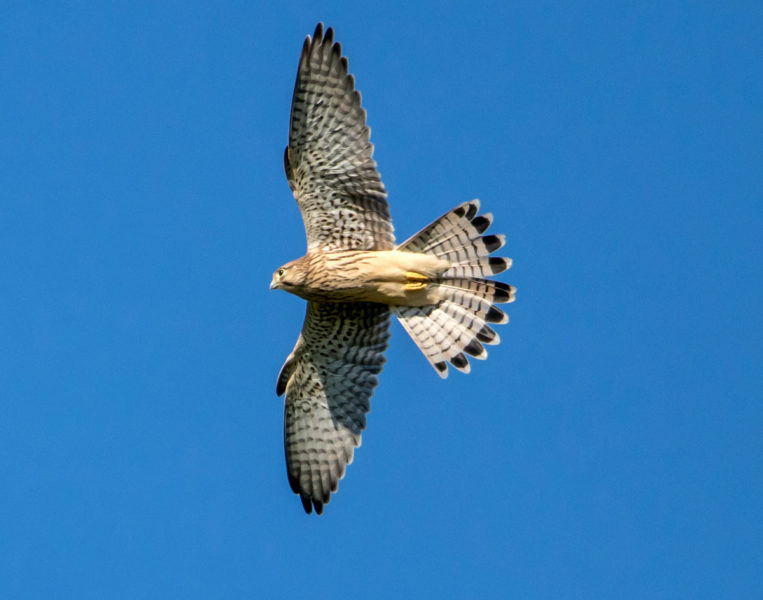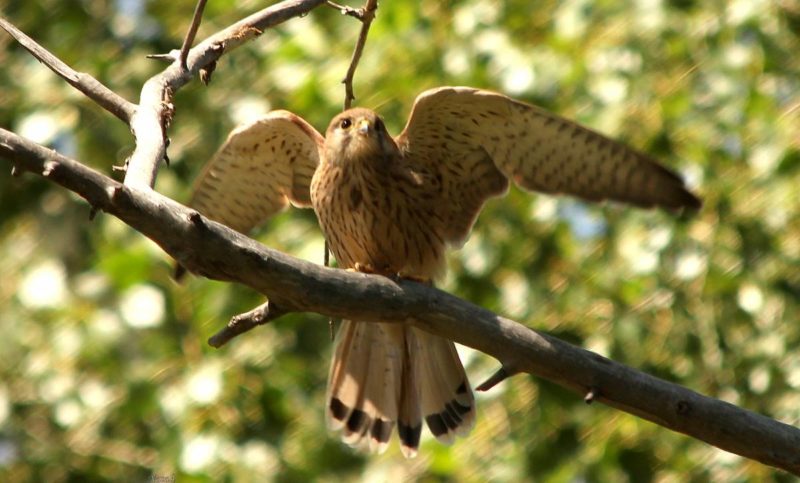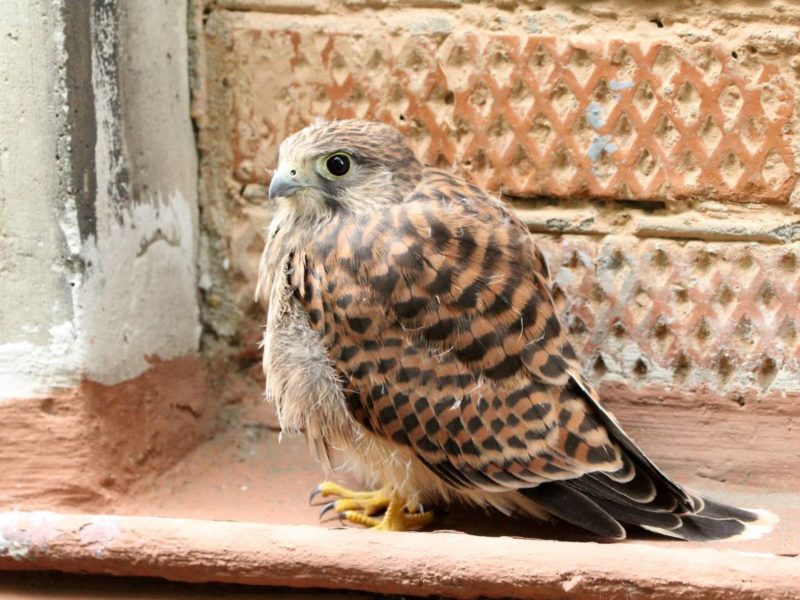A small bird of prey, the common kestrel, belongs to the Falcon family. It is widespread in the Old World, it can be found in Eurasia and Africa. The bird has mastered almost all climatic zones and even adapted to life in cities.
Material Content:
Kestrel description and habitat
It is the smallest falcon in the world with black eyes, a short bent beak and a brownish-brown plumage. Males are slightly smaller than females and slightly different in color.
Type Description:
- males have a gray head and dark rhomboid spots on a brown back, tail feathers and lower back are gray;
- black stripes with a snow-white border are visible at the end of the tail in males;
- females of uniform brown-brown color with streaks.
The body sizes of different subspecies and specific bird specimens may vary. On average, an adult, well-fed, a male weighs 200 grams, a female during laying - 300 grams. The heavier the female, the more successful the laying and hatching of the chicks. The body length of the bird is about 35 cm, and the wingspan is 75 cm.
Typically, these birds use ascending air currents to soar. They always fly facing a headwind, so their name in Ukrainian sounds like “Boriviter.” Depending on the region of habitat, birds can be settled, roaming or migratory. If during the cold season, the amount of feed is not enough for survival, the flocks migrate to warmer regions. They can fly over the mountain peaks of Europe, which stand in the way, but more often take the route along the mountain passes.
For habitat, kestrels (falco tinnunculus) choose open spaces with a small number of trees. They avoid settling in forests and treeless European steppes.Bird hunting grounds are landscapes with low grass. Birds living in the forest-steppe, during nesting, form flocks comprising from 2 to 100 pairs.
Nutrition and Eating Behavior of the Falcon
Kestrels living in the steppe feed on voles; urban falcons often catch sparrows and small songbirds. The diet of poultry depends on the region of residence. In southern European countries, small lizards become the main food. If there are few rodents and lizards, the kestrel eats grasshoppers. bugs, earthworms. First-time baby birds also feed on insects, and only after gaining experience do they begin to hunt for larger game.
The kestrel falcon uses a special fluttering flight to search for prey. Hovering in one place, the bird is looking for a victim. At the same time, her tail is fan-shaped, and her wings make frequent flaps. The bird eats the captured rodents together with bones, entrails and the skin, tearing its beak and paws into small pieces.
A bird hunts successfully in the winter from an attack using tall trees or a picket fence. Dive from a height during flight is most often used in the summer, especially if he sees a large flock of small birds occupying a section of the field.
Reproduction and longevity
The voice of the kestrel can be heard from March to April. The male accompanies his flight with turns with inviting cries, trying to attract the female and inform his fellow tribesmen about the boundaries of his site. The female also invites to pairing: she flies up to the partner, making a squeak like a hungry chick.
Kestrel builds nests on trees, in cracked rocks or clay cliffs. If there is no high vegetation in its habitats, it nests on poles of power lines. The female lays 6 motley eggs and hatch them until the chicks appear. In case of danger, flies over the nest, issuing an alarming crack.
In nature, the kestrel lives up to 16 years or more. Ornithologists were able to establish this thanks to the observation of ringed birds. But young animals sometimes do not live for more than a year, and a fly that has flown out of the nest has only a 50% chance of surviving. This is due to malnutrition in January – February, when it is especially difficult for young birds to get food.
Features of kestrel hunting
Kestrels feed on large insects and small vertebrates. They track prey in flight. With 2.5 times better vision than humans, they easily notice rodents in the grass from a height of 20 meters. In addition, these birds can see in the ultraviolet spectrum, which allows them to find not only potential prey, but even its traces left on the ground.
Noticing a mouse in the grass, a soaring kestrel throws a stone down, slowing down only near the ground. An interesting feature of a bird is its ability to flutter when it quickly and quickly moves wings in the air, moving large masses of air. So she hangs at one point to view the prey on the ground.
Natural enemies
The family of falcons, in particular the kestrel, is not engaged in the independent construction of nests, laying eggs in the crows or magpies left. These birds can destroy eggs and kestrel chicks. Martens also destroy nests.
In Malta, the kestrel population completely disappeared as a result of shooting by amateur hunters. The bird suffers from human activities. The use of pesticides in the fields leads to the disappearance of available feed.
Interesting Facts
The falcon is quickly tamed, it can be kept at home. However, creating comfortable conditions for him is not so simple. It can not be put in a cage, like other birds: the falcon frantically beats against the rods until all feathers are consumed. A large aviary with glass is suitable instead of rods, or you will have to make an outfit for bird of prey and an additive known from ancient times. You can do the necessary things with your own hands by reading the relevant literature (Dementiev, Flint, etc.).
You can walk with a home falcon.For training and walking you will need a glove so that your hands are not punctured all the time. Ammunition can be ordered or you can use a men's leather glove with your left hand, sewing a ring under the debtor to your wrist. To tame a falcon, you need to feed it with your hands and get it to eat on a glove. Otherwise, he will remain wild.
In nature, the kestrel eats daily live food, equal in weight to a quarter of its body mass. This amount is enough for her to replenish energy costs. At home, a bird can die if overfed. Grinded bones or eggshells must be added to meat.
Kestrel in flight while hunting is a beautiful sight. Better to admire her in nature than to keep at home.

















